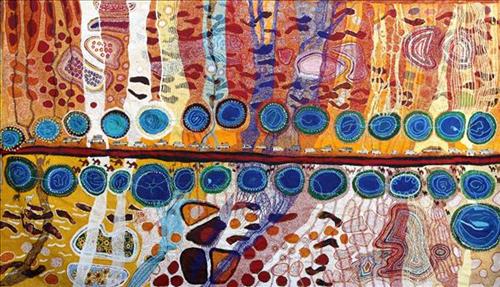11151031973
Canning Stock Route- Our Country
Work on this painting commenced at Parnngurr Community in September 2011. The canvas was rolled out and Judith Anya Samson, under Kumpaya’s instruction, painted the road and waterholes. Mid way through the waterholes being put down Kumpaya jumped in and started painting with Judith, soon a large number of artists were involved.
The painting was worked on at Parnngurr on and off for two weeks and finally completed by Kumpaya and Kathleen after ten days of nonstop painting to complete the detail.
The painting depicts the Canning Stock Route and the wells along it, more importantly it illustrates the artists intimate knowledge of their Country, the importance of fire to manage Country, the vast sand hills and underground water sources, the song lines , the Jukurrpa (Martu dreaming). The creation of this work provides an opportunity for young and old artists to work together, sharing knowledge and skills.
“There’s minyi puru (seven sisters) all through this painting, the seven sisters stopped all through this country, at all of the waterholes”
“The Jina (feet) show where Martu walked in pujiman, all through the desert, we still walk through our country, now there are lots of Toyotas on the CSR, tourists, Martu and the Martu rangers working on the country to look after it”
“You can see the pattern waru (Fire) makes on country and how much water there is in the desert, Martu know how to find this water, not just the water in CSR wells”
“Kunawarritji is the big waterhole; it’s my home, its lovely country”
– Kumpaya Girgirba
Western Australia’s gold rush, beginning in 1885, created a huge demand for beef from mines located between Halls Creek and Wiluna. At that time, most of Western Australia’s cattle came from the Kimberley, though an infestation of tropical ticks among the East Kimberley herds gave the West Kimberley pastoralists a monopoly on the beef trade — causing prices to soar. A Royal Commission in 1904 proposed the construction of a stock route through Western Australia’s desert country to eliminate the ticks through exposure to its hot, dry conditions, resulting in the near 2000 kilometre Canning Stock Route. The proposal was successful insofar as the eradication of ticks was concerned; however, the establishment of the Canning Stock Route was to have far reaching repercussions for Western Australia’s Aboriginal population.
The construction of the route by Alfred Canning and his team in 1910 resulted in first contact with Europeans for many Martu then living a pujiman (traditional, desert dwelling) life in the desert. This contact began with Canning’s use of Aboriginal guides to lead him to the sources of water that would be transformed into 48 stock route wells. Acts of cruelty toward these guides included, amongst other things, chaining them at night to prevent their escape and giving them salt water to drink, thereby ensuring their thirst and subsequent necessity to lead the party to water sources.
Following the construction of the Canning Stock Route, Martu encountered Europeans and other Martu working as cattle drovers as they would travel up and down the Stock Route from water source to water source. Increasingly, pujiman followed the route to newly established ration depots, mission and pastoral stations. They were drawn to the route in search of food, by a sense of curiosity, or by loneliness. By the late 1950s and early 1960s, most of the desert family groups had left the desert. Eventually, these factors combined with an extreme and prolonged drought in the 1960s to prompt the few remaining pujiman to move in from the desert. One of the last major migrations of Martu people occurred in 1963, when many of the pujiman born Martumili Artists moved to Jigalong.
Patterns of movement which had defined Aboriginal people’s relationships to Country were forever changed by the Canning Stock Route, but the Martu relationship with Country remains strong through the maintenance of physical and cultural ties to desert life and knowledge.



